Climate Change's Impact on Women's Health: A Qualitative Study
VerifiedAdded on 2022/11/26
|24
|5496
|132
Report
AI Summary
This report presents a qualitative study investigating the impact of climate change on the health of women, particularly international students in Melbourne, Australia. The research employed a qualitative methodology, including one-on-one interviews with five international students from various countries. The study aimed to explore the participants' experiences with climate-related health issues, such as skin problems, hair fall, gastrointestinal issues, mental health concerns, and menstrual irregularities. The findings revealed that the transition to Melbourne's climate was associated with diverse experiences, with some students experiencing adverse health effects while others found the climate pleasant. The report discusses the research methods, including the use of thematic analysis to interpret the interview data. It highlights the limitations of the study, such as the small sample size, and suggests the need for further research to confirm these preliminary findings. The report also includes a critical review of existing literature and data in Melbourne and Australia, research question, objectives and its importance. The research contributes to a better understanding of the relationship between climate change and women's health, highlighting the need for tailored interventions and support for vulnerable populations.

Running head: HEALTHCARE
HEALTHCARE
Name of the Student:
Name of the University:
Author Note:
HEALTHCARE
Name of the Student:
Name of the University:
Author Note:
Paraphrase This Document
Need a fresh take? Get an instant paraphrase of this document with our AI Paraphraser

1HEALTHCARE
Abstract:
Research studies have suggested that climate change elicits a significant impact on the
physical health of people. However, research is limited in terms of evaluating the impact of
climate change on women. The primary aim of this research is to evaluate the impact of
climate on the International students and evaluate their experience in terms of any physical
health issues. The research question for the research can be mentioned as: What are the
impacts of climate change on women’s health in the Australian Context?
The research objectives included, investigating the evidence base in order to evaluate
measures by which the impact of climate change on women’s health can be estimated and to
understand the climate changes experienced by the international female students on arriving
Melbourne. The researcher conducted a one-on-one personal interview with five international
students who belonged to India, Sri Lanka, Nepal and China. The overall findings of the
research mentioned that the participants experienced issues in terms of skin problems, hair
problems, gastrointestinal problems, mental health problems and abnormality in menstrual
health. Due to the limitation of the sample size and lack of evidence based literature to
support the findings it can be said that the problems could also be a result of diet and lifestyle
problems and thus needs further research.
Abstract:
Research studies have suggested that climate change elicits a significant impact on the
physical health of people. However, research is limited in terms of evaluating the impact of
climate change on women. The primary aim of this research is to evaluate the impact of
climate on the International students and evaluate their experience in terms of any physical
health issues. The research question for the research can be mentioned as: What are the
impacts of climate change on women’s health in the Australian Context?
The research objectives included, investigating the evidence base in order to evaluate
measures by which the impact of climate change on women’s health can be estimated and to
understand the climate changes experienced by the international female students on arriving
Melbourne. The researcher conducted a one-on-one personal interview with five international
students who belonged to India, Sri Lanka, Nepal and China. The overall findings of the
research mentioned that the participants experienced issues in terms of skin problems, hair
problems, gastrointestinal problems, mental health problems and abnormality in menstrual
health. Due to the limitation of the sample size and lack of evidence based literature to
support the findings it can be said that the problems could also be a result of diet and lifestyle
problems and thus needs further research.

2HEALTHCARE
Introduction:
Climate change elicits a significant impact on the health of the people. Climate
changes includes a set of primary characteristics such as exposure to heat, poor quality of air,
extremes of weather conditions, poor quality of water, poor food security and impaired
vector-borne disease transmission (Smith et al. 2014; Sorensen et al. 2018). It should be
mentioned in this context that the impact of climate change on health has affected both the
genders differently on account of variance witnessed in relation to the biological,
socioeconomic as well as the cultural factors (McMichael 2013; Whittenbury 2013). It should
further be stated in this context that impact of climate change has adversely affected the
Australian population targeting the female population. Australia has primarily witnessed an
arid climate and with the increase in global warming, the rate of precipitation is expected to
increase in the tropical areas and decrease within the temperate areas (Head et al. 2014). In
addition to this, the impact of the changes would trigger bushfires and increase in the
frequency of floods. Further, as per, Dennekamp et al. (2015), smoke generated from forest
fires has been studied to be the main contributing factor for cardiac arrest among residents of
Melbourne who had been exposed to smoke for a long period of time. Also, Akompab et al.
(2013), in their research paper stated that Adelaide has been subjected to unprecedented heat
waves for a long period of time that has affected the personal comfort and the normal
sleeping pattern of the residents of Adelaide. Also, Whittenbury (2012) stated that lack of
fresh water availability is impacting the wellness of the rural women in Australia. Therefore,
it can be said that climate change has emerged as a serious issue in Australia which needs
further evaluation so as to propose and implement relevant solutions.
Introduction:
Climate change elicits a significant impact on the health of the people. Climate
changes includes a set of primary characteristics such as exposure to heat, poor quality of air,
extremes of weather conditions, poor quality of water, poor food security and impaired
vector-borne disease transmission (Smith et al. 2014; Sorensen et al. 2018). It should be
mentioned in this context that the impact of climate change on health has affected both the
genders differently on account of variance witnessed in relation to the biological,
socioeconomic as well as the cultural factors (McMichael 2013; Whittenbury 2013). It should
further be stated in this context that impact of climate change has adversely affected the
Australian population targeting the female population. Australia has primarily witnessed an
arid climate and with the increase in global warming, the rate of precipitation is expected to
increase in the tropical areas and decrease within the temperate areas (Head et al. 2014). In
addition to this, the impact of the changes would trigger bushfires and increase in the
frequency of floods. Further, as per, Dennekamp et al. (2015), smoke generated from forest
fires has been studied to be the main contributing factor for cardiac arrest among residents of
Melbourne who had been exposed to smoke for a long period of time. Also, Akompab et al.
(2013), in their research paper stated that Adelaide has been subjected to unprecedented heat
waves for a long period of time that has affected the personal comfort and the normal
sleeping pattern of the residents of Adelaide. Also, Whittenbury (2012) stated that lack of
fresh water availability is impacting the wellness of the rural women in Australia. Therefore,
it can be said that climate change has emerged as a serious issue in Australia which needs
further evaluation so as to propose and implement relevant solutions.
⊘ This is a preview!⊘
Do you want full access?
Subscribe today to unlock all pages.

Trusted by 1+ million students worldwide
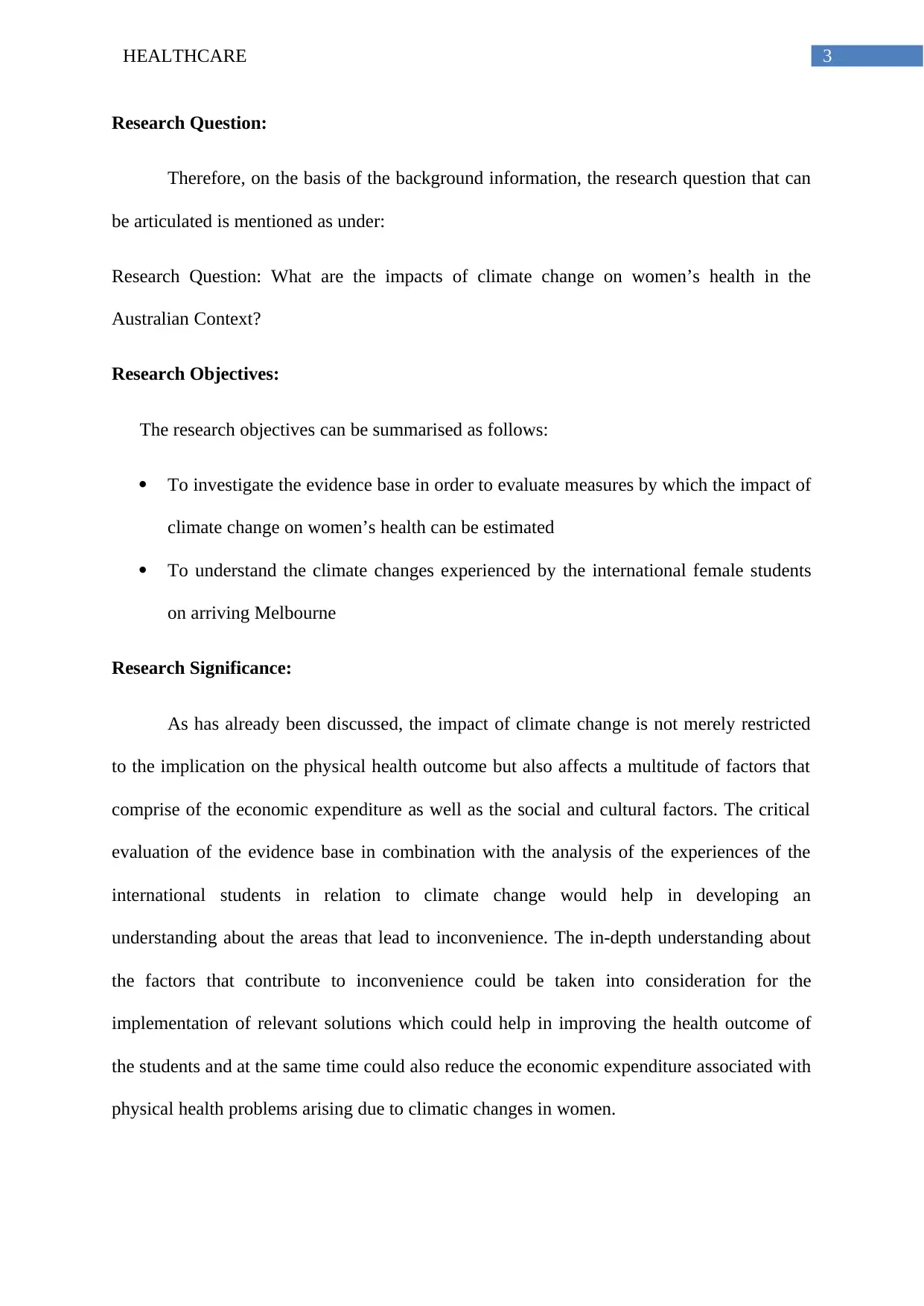
3HEALTHCARE
Research Question:
Therefore, on the basis of the background information, the research question that can
be articulated is mentioned as under:
Research Question: What are the impacts of climate change on women’s health in the
Australian Context?
Research Objectives:
The research objectives can be summarised as follows:
To investigate the evidence base in order to evaluate measures by which the impact of
climate change on women’s health can be estimated
To understand the climate changes experienced by the international female students
on arriving Melbourne
Research Significance:
As has already been discussed, the impact of climate change is not merely restricted
to the implication on the physical health outcome but also affects a multitude of factors that
comprise of the economic expenditure as well as the social and cultural factors. The critical
evaluation of the evidence base in combination with the analysis of the experiences of the
international students in relation to climate change would help in developing an
understanding about the areas that lead to inconvenience. The in-depth understanding about
the factors that contribute to inconvenience could be taken into consideration for the
implementation of relevant solutions which could help in improving the health outcome of
the students and at the same time could also reduce the economic expenditure associated with
physical health problems arising due to climatic changes in women.
Research Question:
Therefore, on the basis of the background information, the research question that can
be articulated is mentioned as under:
Research Question: What are the impacts of climate change on women’s health in the
Australian Context?
Research Objectives:
The research objectives can be summarised as follows:
To investigate the evidence base in order to evaluate measures by which the impact of
climate change on women’s health can be estimated
To understand the climate changes experienced by the international female students
on arriving Melbourne
Research Significance:
As has already been discussed, the impact of climate change is not merely restricted
to the implication on the physical health outcome but also affects a multitude of factors that
comprise of the economic expenditure as well as the social and cultural factors. The critical
evaluation of the evidence base in combination with the analysis of the experiences of the
international students in relation to climate change would help in developing an
understanding about the areas that lead to inconvenience. The in-depth understanding about
the factors that contribute to inconvenience could be taken into consideration for the
implementation of relevant solutions which could help in improving the health outcome of
the students and at the same time could also reduce the economic expenditure associated with
physical health problems arising due to climatic changes in women.
Paraphrase This Document
Need a fresh take? Get an instant paraphrase of this document with our AI Paraphraser
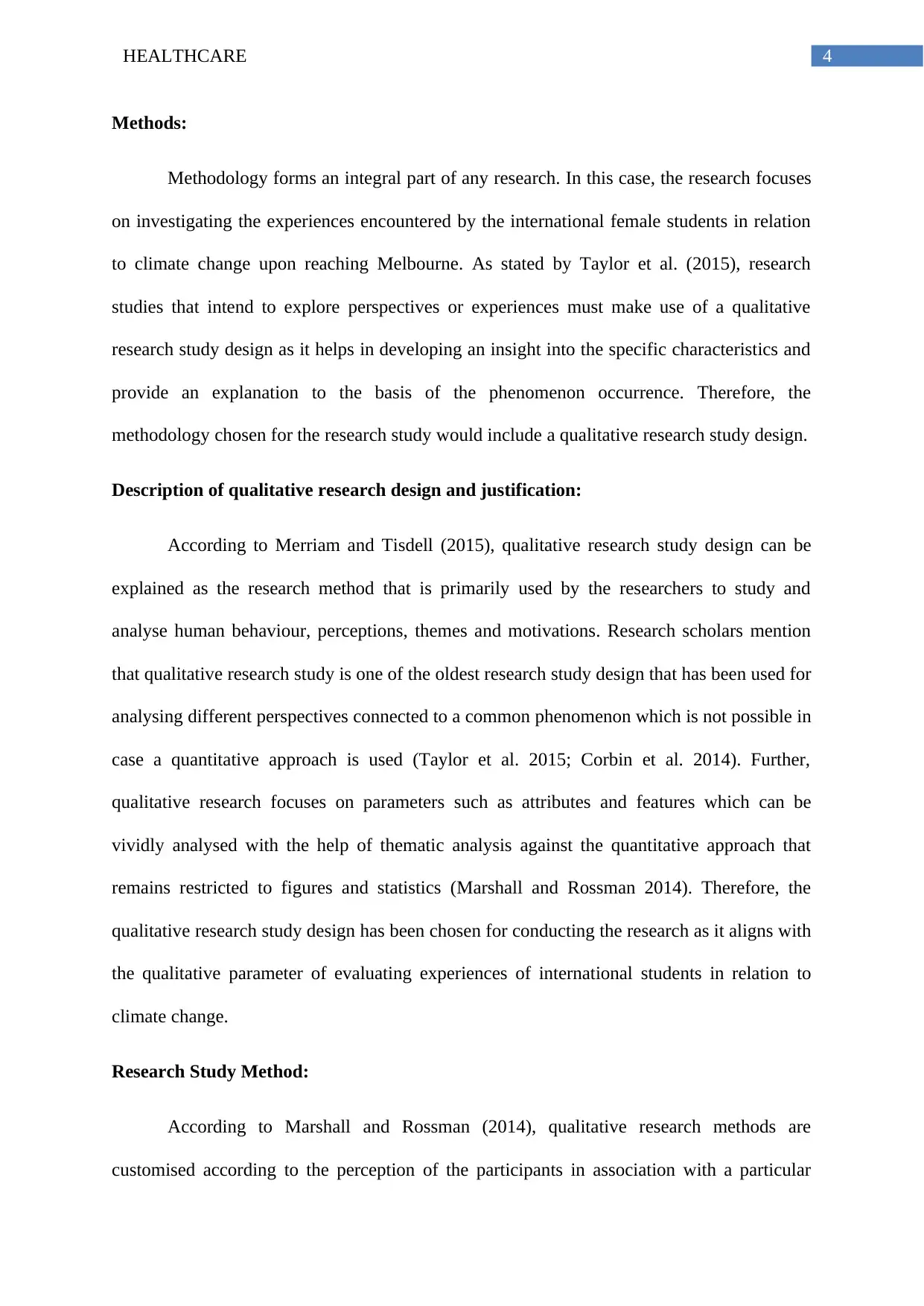
4HEALTHCARE
Methods:
Methodology forms an integral part of any research. In this case, the research focuses
on investigating the experiences encountered by the international female students in relation
to climate change upon reaching Melbourne. As stated by Taylor et al. (2015), research
studies that intend to explore perspectives or experiences must make use of a qualitative
research study design as it helps in developing an insight into the specific characteristics and
provide an explanation to the basis of the phenomenon occurrence. Therefore, the
methodology chosen for the research study would include a qualitative research study design.
Description of qualitative research design and justification:
According to Merriam and Tisdell (2015), qualitative research study design can be
explained as the research method that is primarily used by the researchers to study and
analyse human behaviour, perceptions, themes and motivations. Research scholars mention
that qualitative research study is one of the oldest research study design that has been used for
analysing different perspectives connected to a common phenomenon which is not possible in
case a quantitative approach is used (Taylor et al. 2015; Corbin et al. 2014). Further,
qualitative research focuses on parameters such as attributes and features which can be
vividly analysed with the help of thematic analysis against the quantitative approach that
remains restricted to figures and statistics (Marshall and Rossman 2014). Therefore, the
qualitative research study design has been chosen for conducting the research as it aligns with
the qualitative parameter of evaluating experiences of international students in relation to
climate change.
Research Study Method:
According to Marshall and Rossman (2014), qualitative research methods are
customised according to the perception of the participants in association with a particular
Methods:
Methodology forms an integral part of any research. In this case, the research focuses
on investigating the experiences encountered by the international female students in relation
to climate change upon reaching Melbourne. As stated by Taylor et al. (2015), research
studies that intend to explore perspectives or experiences must make use of a qualitative
research study design as it helps in developing an insight into the specific characteristics and
provide an explanation to the basis of the phenomenon occurrence. Therefore, the
methodology chosen for the research study would include a qualitative research study design.
Description of qualitative research design and justification:
According to Merriam and Tisdell (2015), qualitative research study design can be
explained as the research method that is primarily used by the researchers to study and
analyse human behaviour, perceptions, themes and motivations. Research scholars mention
that qualitative research study is one of the oldest research study design that has been used for
analysing different perspectives connected to a common phenomenon which is not possible in
case a quantitative approach is used (Taylor et al. 2015; Corbin et al. 2014). Further,
qualitative research focuses on parameters such as attributes and features which can be
vividly analysed with the help of thematic analysis against the quantitative approach that
remains restricted to figures and statistics (Marshall and Rossman 2014). Therefore, the
qualitative research study design has been chosen for conducting the research as it aligns with
the qualitative parameter of evaluating experiences of international students in relation to
climate change.
Research Study Method:
According to Marshall and Rossman (2014), qualitative research methods are
customised according to the perception of the participants in association with a particular

5HEALTHCARE
research topic. Further, qualitative research methods have evolved from the domain of social
and behavioural sciences. The most widely used qualitative research methods comprise of
one-on-one interview, focus groups. Ethnographic research, case study research, record
keeping as well as the process of observation (Taylor et al. 2015). In this case, the research
method that would be chosen would comprise of conducting one-on-one interview with the
recruited research participants. The rationale for the same can be explained in the words of
Corbin et al. (2014), who suggested that personal interviews allowed a researcher to obtain in
depth details about a participant and at the same time helped in the collection of rigorous and
elaborate data. As stated by Marshall and Rossman (2014), face to face personal interviews
allowed the researchers to analyse the body language of the participants in relation to the
obtained responses so as to analyse the gathered data from a broader perspective and develop
an insight about the existing belief of the participants. On the other hand, focus group
research methods are suitable for a group of target audience. Also, ethnographic research
method is suited perfectly for studying audiences within a confined environment and
therefore includes the possibility of biases in opinions (Corbin et al. 2014). Case study
research method is however best suited for studying an organization and the method of record
keeping only offers a provision to include what is already known in relation to a specific
research perspective (Merriam and Tisdell 2015). Further, the process of qualitative
observation is most commonly used for the evaluation of quality differences (Corbin et al.
2014). In this case, the one on one interview method would be used in order to collect
responses from the participants in relation to the impact of climate change experienced in
Melbourne.
Recruitment Strategy:
The research was conducted in the University of Melbourne where the participants
were chosen on the basis of random sampling. Prior to the research, approval was sought
research topic. Further, qualitative research methods have evolved from the domain of social
and behavioural sciences. The most widely used qualitative research methods comprise of
one-on-one interview, focus groups. Ethnographic research, case study research, record
keeping as well as the process of observation (Taylor et al. 2015). In this case, the research
method that would be chosen would comprise of conducting one-on-one interview with the
recruited research participants. The rationale for the same can be explained in the words of
Corbin et al. (2014), who suggested that personal interviews allowed a researcher to obtain in
depth details about a participant and at the same time helped in the collection of rigorous and
elaborate data. As stated by Marshall and Rossman (2014), face to face personal interviews
allowed the researchers to analyse the body language of the participants in relation to the
obtained responses so as to analyse the gathered data from a broader perspective and develop
an insight about the existing belief of the participants. On the other hand, focus group
research methods are suitable for a group of target audience. Also, ethnographic research
method is suited perfectly for studying audiences within a confined environment and
therefore includes the possibility of biases in opinions (Corbin et al. 2014). Case study
research method is however best suited for studying an organization and the method of record
keeping only offers a provision to include what is already known in relation to a specific
research perspective (Merriam and Tisdell 2015). Further, the process of qualitative
observation is most commonly used for the evaluation of quality differences (Corbin et al.
2014). In this case, the one on one interview method would be used in order to collect
responses from the participants in relation to the impact of climate change experienced in
Melbourne.
Recruitment Strategy:
The research was conducted in the University of Melbourne where the participants
were chosen on the basis of random sampling. Prior to the research, approval was sought
⊘ This is a preview!⊘
Do you want full access?
Subscribe today to unlock all pages.

Trusted by 1+ million students worldwide
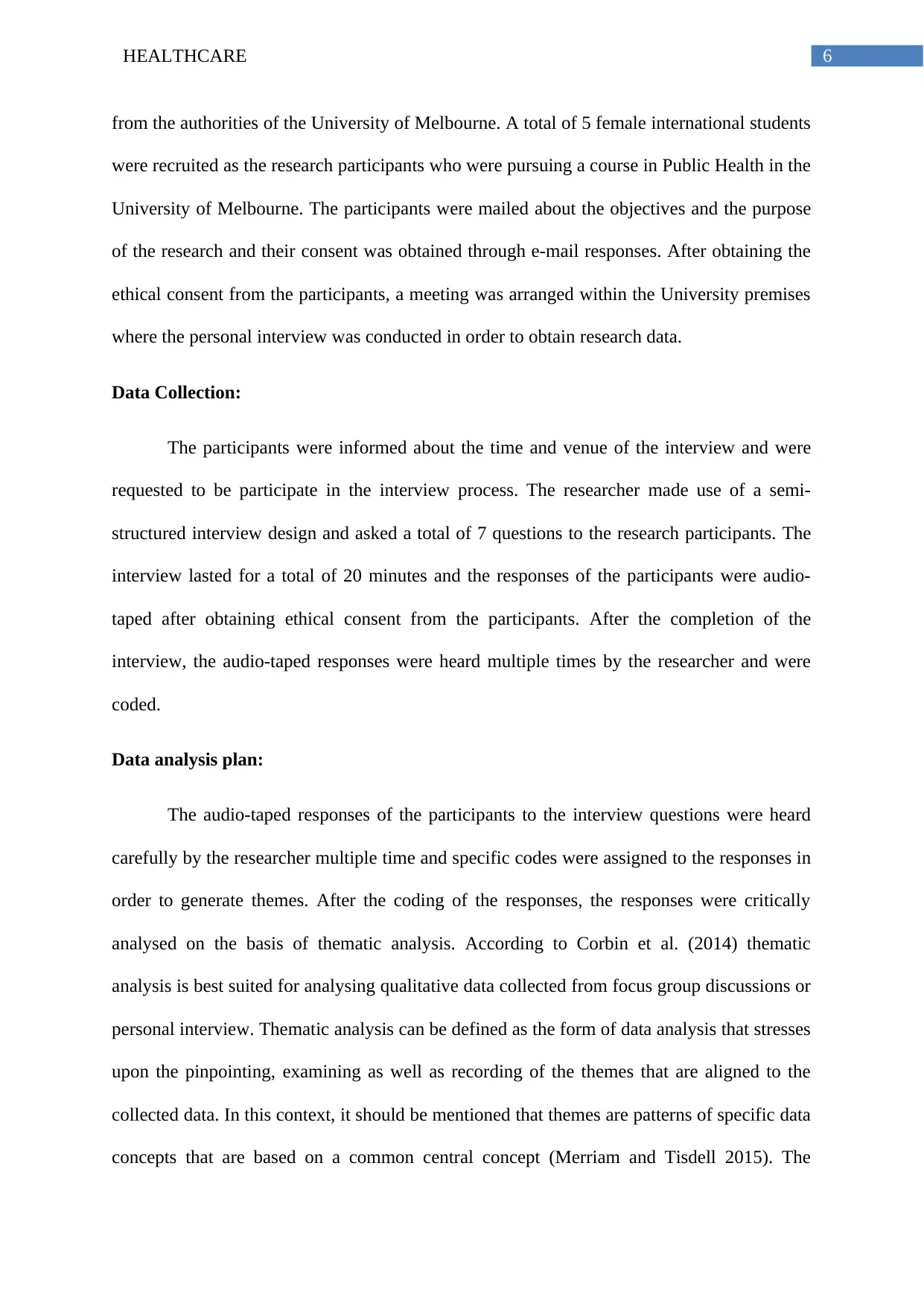
6HEALTHCARE
from the authorities of the University of Melbourne. A total of 5 female international students
were recruited as the research participants who were pursuing a course in Public Health in the
University of Melbourne. The participants were mailed about the objectives and the purpose
of the research and their consent was obtained through e-mail responses. After obtaining the
ethical consent from the participants, a meeting was arranged within the University premises
where the personal interview was conducted in order to obtain research data.
Data Collection:
The participants were informed about the time and venue of the interview and were
requested to be participate in the interview process. The researcher made use of a semi-
structured interview design and asked a total of 7 questions to the research participants. The
interview lasted for a total of 20 minutes and the responses of the participants were audio-
taped after obtaining ethical consent from the participants. After the completion of the
interview, the audio-taped responses were heard multiple times by the researcher and were
coded.
Data analysis plan:
The audio-taped responses of the participants to the interview questions were heard
carefully by the researcher multiple time and specific codes were assigned to the responses in
order to generate themes. After the coding of the responses, the responses were critically
analysed on the basis of thematic analysis. According to Corbin et al. (2014) thematic
analysis is best suited for analysing qualitative data collected from focus group discussions or
personal interview. Thematic analysis can be defined as the form of data analysis that stresses
upon the pinpointing, examining as well as recording of the themes that are aligned to the
collected data. In this context, it should be mentioned that themes are patterns of specific data
concepts that are based on a common central concept (Merriam and Tisdell 2015). The
from the authorities of the University of Melbourne. A total of 5 female international students
were recruited as the research participants who were pursuing a course in Public Health in the
University of Melbourne. The participants were mailed about the objectives and the purpose
of the research and their consent was obtained through e-mail responses. After obtaining the
ethical consent from the participants, a meeting was arranged within the University premises
where the personal interview was conducted in order to obtain research data.
Data Collection:
The participants were informed about the time and venue of the interview and were
requested to be participate in the interview process. The researcher made use of a semi-
structured interview design and asked a total of 7 questions to the research participants. The
interview lasted for a total of 20 minutes and the responses of the participants were audio-
taped after obtaining ethical consent from the participants. After the completion of the
interview, the audio-taped responses were heard multiple times by the researcher and were
coded.
Data analysis plan:
The audio-taped responses of the participants to the interview questions were heard
carefully by the researcher multiple time and specific codes were assigned to the responses in
order to generate themes. After the coding of the responses, the responses were critically
analysed on the basis of thematic analysis. According to Corbin et al. (2014) thematic
analysis is best suited for analysing qualitative data collected from focus group discussions or
personal interview. Thematic analysis can be defined as the form of data analysis that stresses
upon the pinpointing, examining as well as recording of the themes that are aligned to the
collected data. In this context, it should be mentioned that themes are patterns of specific data
concepts that are based on a common central concept (Merriam and Tisdell 2015). The
Paraphrase This Document
Need a fresh take? Get an instant paraphrase of this document with our AI Paraphraser
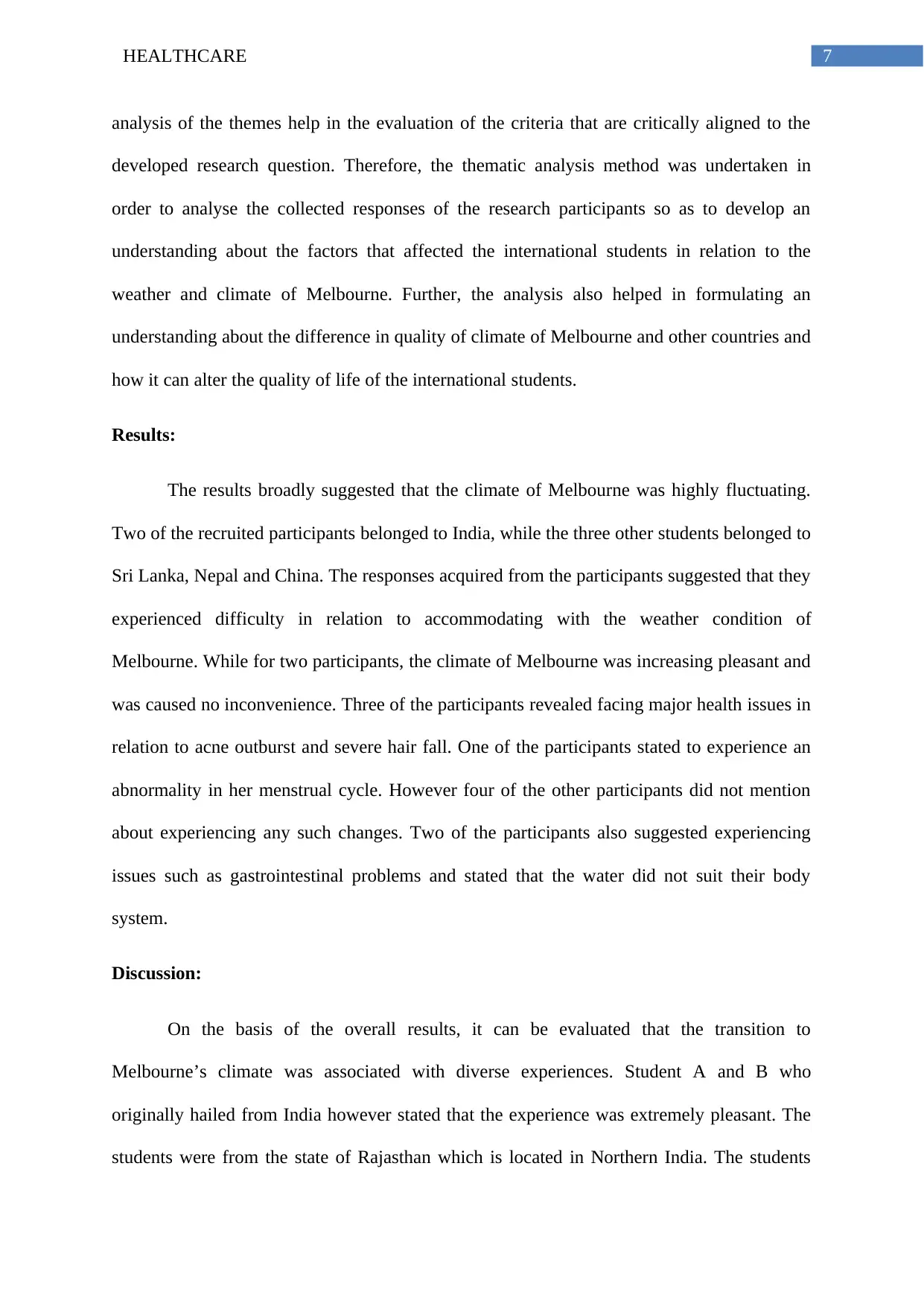
7HEALTHCARE
analysis of the themes help in the evaluation of the criteria that are critically aligned to the
developed research question. Therefore, the thematic analysis method was undertaken in
order to analyse the collected responses of the research participants so as to develop an
understanding about the factors that affected the international students in relation to the
weather and climate of Melbourne. Further, the analysis also helped in formulating an
understanding about the difference in quality of climate of Melbourne and other countries and
how it can alter the quality of life of the international students.
Results:
The results broadly suggested that the climate of Melbourne was highly fluctuating.
Two of the recruited participants belonged to India, while the three other students belonged to
Sri Lanka, Nepal and China. The responses acquired from the participants suggested that they
experienced difficulty in relation to accommodating with the weather condition of
Melbourne. While for two participants, the climate of Melbourne was increasing pleasant and
was caused no inconvenience. Three of the participants revealed facing major health issues in
relation to acne outburst and severe hair fall. One of the participants stated to experience an
abnormality in her menstrual cycle. However four of the other participants did not mention
about experiencing any such changes. Two of the participants also suggested experiencing
issues such as gastrointestinal problems and stated that the water did not suit their body
system.
Discussion:
On the basis of the overall results, it can be evaluated that the transition to
Melbourne’s climate was associated with diverse experiences. Student A and B who
originally hailed from India however stated that the experience was extremely pleasant. The
students were from the state of Rajasthan which is located in Northern India. The students
analysis of the themes help in the evaluation of the criteria that are critically aligned to the
developed research question. Therefore, the thematic analysis method was undertaken in
order to analyse the collected responses of the research participants so as to develop an
understanding about the factors that affected the international students in relation to the
weather and climate of Melbourne. Further, the analysis also helped in formulating an
understanding about the difference in quality of climate of Melbourne and other countries and
how it can alter the quality of life of the international students.
Results:
The results broadly suggested that the climate of Melbourne was highly fluctuating.
Two of the recruited participants belonged to India, while the three other students belonged to
Sri Lanka, Nepal and China. The responses acquired from the participants suggested that they
experienced difficulty in relation to accommodating with the weather condition of
Melbourne. While for two participants, the climate of Melbourne was increasing pleasant and
was caused no inconvenience. Three of the participants revealed facing major health issues in
relation to acne outburst and severe hair fall. One of the participants stated to experience an
abnormality in her menstrual cycle. However four of the other participants did not mention
about experiencing any such changes. Two of the participants also suggested experiencing
issues such as gastrointestinal problems and stated that the water did not suit their body
system.
Discussion:
On the basis of the overall results, it can be evaluated that the transition to
Melbourne’s climate was associated with diverse experiences. Student A and B who
originally hailed from India however stated that the experience was extremely pleasant. The
students were from the state of Rajasthan which is located in Northern India. The students

8HEALTHCARE
mentioned that the climate of Rajasthan was arid and that the temperatures varied between
the extremes during the summer and winter season. The climate of Rajasthan has been
classifies as hot desert type as per the Koppen Climate classification and the area receives
little or no rainfall and is characterized by frequent droughts (Smith et al. 2014). On the
contrary, as per the Koppen climate classification, the Australian climate is equivalent to
temperate oceanic type (Smith et al. 2014). This suggests that the temperature in summer
months is within the moderate range and is not characterized by intense heat. Further, on
account of the closeness to Coral Sea the summers are usually pleasant with occasional days
of intense heat. On the other hand, the winters are usually cool with moderate amount of
precipitation (Head et al. 2014). It should be noted in this context that on differential heating
of the landmasses the summer months are also characterized with strong gales and occasional
thunderstorms which are the result of cold fronts (Head et al. 2014). Therefore, on comparing
the two geographical regions, it can be mentioned that the student responses are valid and
aligned with the natural climatic effect of Melbourne. On the other hand, the student of
Nepal, China and Sri Lanka mentioned that that the water of Melbourne did not suit them and
it caused them problems such as hair fall and acne outburst. Also, the students from China
and Sri Lanka mentioned about experiencing gastrointestinal problems due to the quality of
water. Melbourne’s water system is provisioned by the water suppliers and is regulated by a
comprehensive regulatory framework (Yvw.com.au 2019). The quality of the drinking water
is guaranteed by the Australian Drinking Water guidelines and is routinely monitored for
quality evaluation. However, as stated by Health.vic.gov.au (2019), occasionally treatment
plant issues, floods and growth of cyanobacteria might affect the quality of the water. There
might be a possibility that the water being consumed by the students is of an inferior quality
pertaining to operational issues of the treatment plant and this could have possibly led to the
outburst of acne, hair fall and gastrointestinal issues. On the other hand, water quality of
mentioned that the climate of Rajasthan was arid and that the temperatures varied between
the extremes during the summer and winter season. The climate of Rajasthan has been
classifies as hot desert type as per the Koppen Climate classification and the area receives
little or no rainfall and is characterized by frequent droughts (Smith et al. 2014). On the
contrary, as per the Koppen climate classification, the Australian climate is equivalent to
temperate oceanic type (Smith et al. 2014). This suggests that the temperature in summer
months is within the moderate range and is not characterized by intense heat. Further, on
account of the closeness to Coral Sea the summers are usually pleasant with occasional days
of intense heat. On the other hand, the winters are usually cool with moderate amount of
precipitation (Head et al. 2014). It should be noted in this context that on differential heating
of the landmasses the summer months are also characterized with strong gales and occasional
thunderstorms which are the result of cold fronts (Head et al. 2014). Therefore, on comparing
the two geographical regions, it can be mentioned that the student responses are valid and
aligned with the natural climatic effect of Melbourne. On the other hand, the student of
Nepal, China and Sri Lanka mentioned that that the water of Melbourne did not suit them and
it caused them problems such as hair fall and acne outburst. Also, the students from China
and Sri Lanka mentioned about experiencing gastrointestinal problems due to the quality of
water. Melbourne’s water system is provisioned by the water suppliers and is regulated by a
comprehensive regulatory framework (Yvw.com.au 2019). The quality of the drinking water
is guaranteed by the Australian Drinking Water guidelines and is routinely monitored for
quality evaluation. However, as stated by Health.vic.gov.au (2019), occasionally treatment
plant issues, floods and growth of cyanobacteria might affect the quality of the water. There
might be a possibility that the water being consumed by the students is of an inferior quality
pertaining to operational issues of the treatment plant and this could have possibly led to the
outburst of acne, hair fall and gastrointestinal issues. On the other hand, water quality of
⊘ This is a preview!⊘
Do you want full access?
Subscribe today to unlock all pages.

Trusted by 1+ million students worldwide
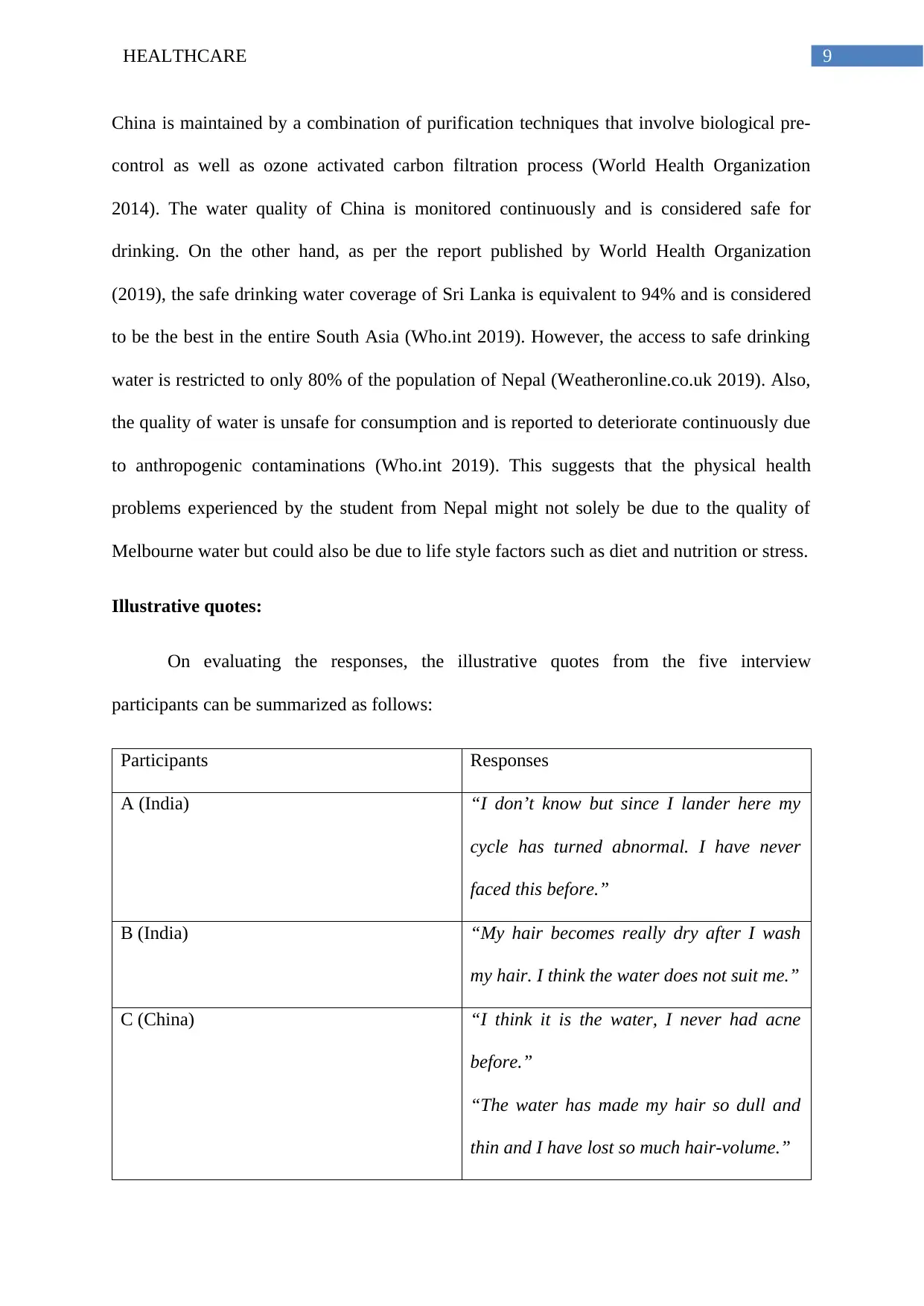
9HEALTHCARE
China is maintained by a combination of purification techniques that involve biological pre-
control as well as ozone activated carbon filtration process (World Health Organization
2014). The water quality of China is monitored continuously and is considered safe for
drinking. On the other hand, as per the report published by World Health Organization
(2019), the safe drinking water coverage of Sri Lanka is equivalent to 94% and is considered
to be the best in the entire South Asia (Who.int 2019). However, the access to safe drinking
water is restricted to only 80% of the population of Nepal (Weatheronline.co.uk 2019). Also,
the quality of water is unsafe for consumption and is reported to deteriorate continuously due
to anthropogenic contaminations (Who.int 2019). This suggests that the physical health
problems experienced by the student from Nepal might not solely be due to the quality of
Melbourne water but could also be due to life style factors such as diet and nutrition or stress.
Illustrative quotes:
On evaluating the responses, the illustrative quotes from the five interview
participants can be summarized as follows:
Participants Responses
A (India) “I don’t know but since I lander here my
cycle has turned abnormal. I have never
faced this before.”
B (India) “My hair becomes really dry after I wash
my hair. I think the water does not suit me.”
C (China) “I think it is the water, I never had acne
before.”
“The water has made my hair so dull and
thin and I have lost so much hair-volume.”
China is maintained by a combination of purification techniques that involve biological pre-
control as well as ozone activated carbon filtration process (World Health Organization
2014). The water quality of China is monitored continuously and is considered safe for
drinking. On the other hand, as per the report published by World Health Organization
(2019), the safe drinking water coverage of Sri Lanka is equivalent to 94% and is considered
to be the best in the entire South Asia (Who.int 2019). However, the access to safe drinking
water is restricted to only 80% of the population of Nepal (Weatheronline.co.uk 2019). Also,
the quality of water is unsafe for consumption and is reported to deteriorate continuously due
to anthropogenic contaminations (Who.int 2019). This suggests that the physical health
problems experienced by the student from Nepal might not solely be due to the quality of
Melbourne water but could also be due to life style factors such as diet and nutrition or stress.
Illustrative quotes:
On evaluating the responses, the illustrative quotes from the five interview
participants can be summarized as follows:
Participants Responses
A (India) “I don’t know but since I lander here my
cycle has turned abnormal. I have never
faced this before.”
B (India) “My hair becomes really dry after I wash
my hair. I think the water does not suit me.”
C (China) “I think it is the water, I never had acne
before.”
“The water has made my hair so dull and
thin and I have lost so much hair-volume.”
Paraphrase This Document
Need a fresh take? Get an instant paraphrase of this document with our AI Paraphraser
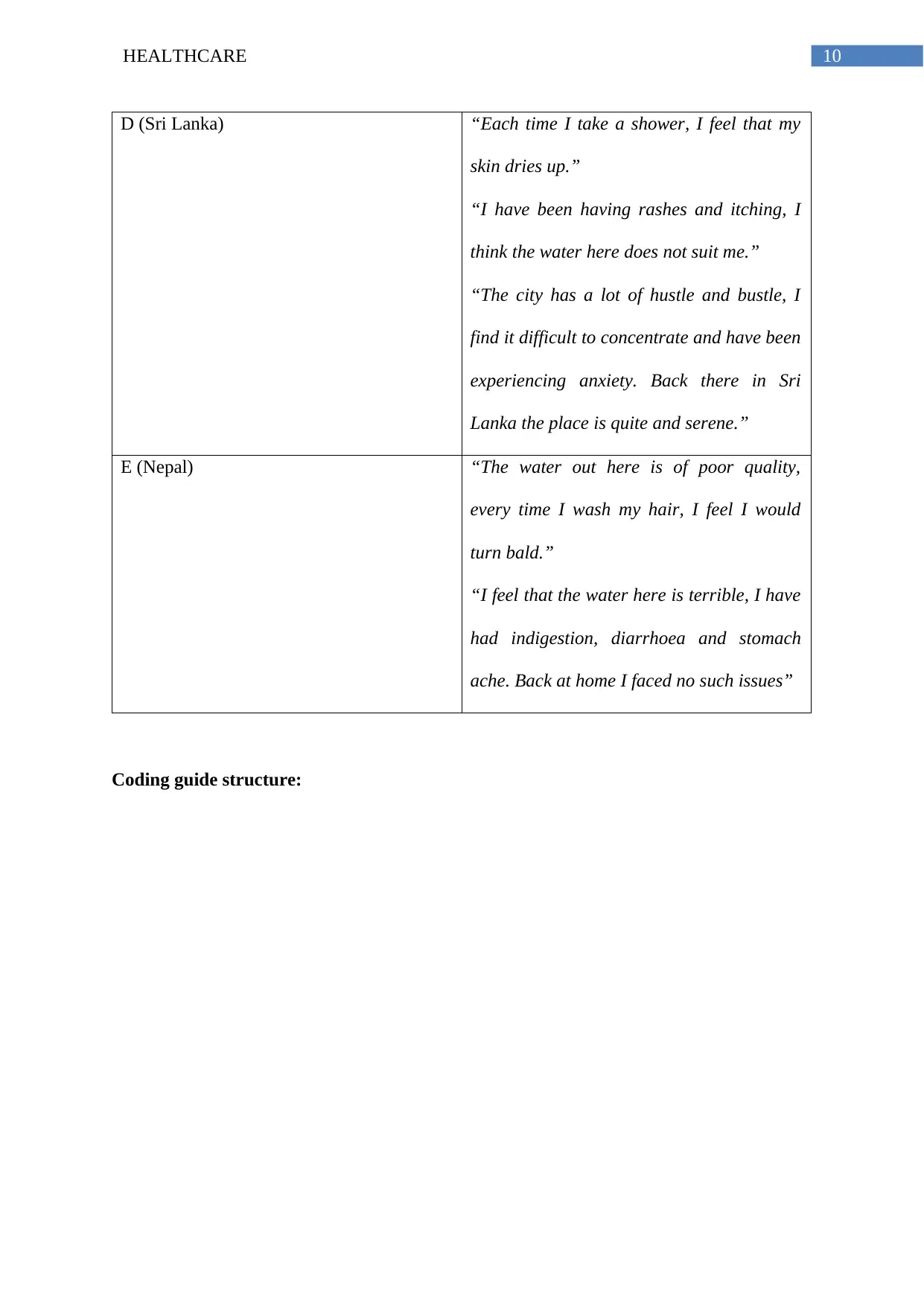
10HEALTHCARE
D (Sri Lanka) “Each time I take a shower, I feel that my
skin dries up.”
“I have been having rashes and itching, I
think the water here does not suit me.”
“The city has a lot of hustle and bustle, I
find it difficult to concentrate and have been
experiencing anxiety. Back there in Sri
Lanka the place is quite and serene.”
E (Nepal) “The water out here is of poor quality,
every time I wash my hair, I feel I would
turn bald.”
“I feel that the water here is terrible, I have
had indigestion, diarrhoea and stomach
ache. Back at home I faced no such issues”
Coding guide structure:
D (Sri Lanka) “Each time I take a shower, I feel that my
skin dries up.”
“I have been having rashes and itching, I
think the water here does not suit me.”
“The city has a lot of hustle and bustle, I
find it difficult to concentrate and have been
experiencing anxiety. Back there in Sri
Lanka the place is quite and serene.”
E (Nepal) “The water out here is of poor quality,
every time I wash my hair, I feel I would
turn bald.”
“I feel that the water here is terrible, I have
had indigestion, diarrhoea and stomach
ache. Back at home I faced no such issues”
Coding guide structure:
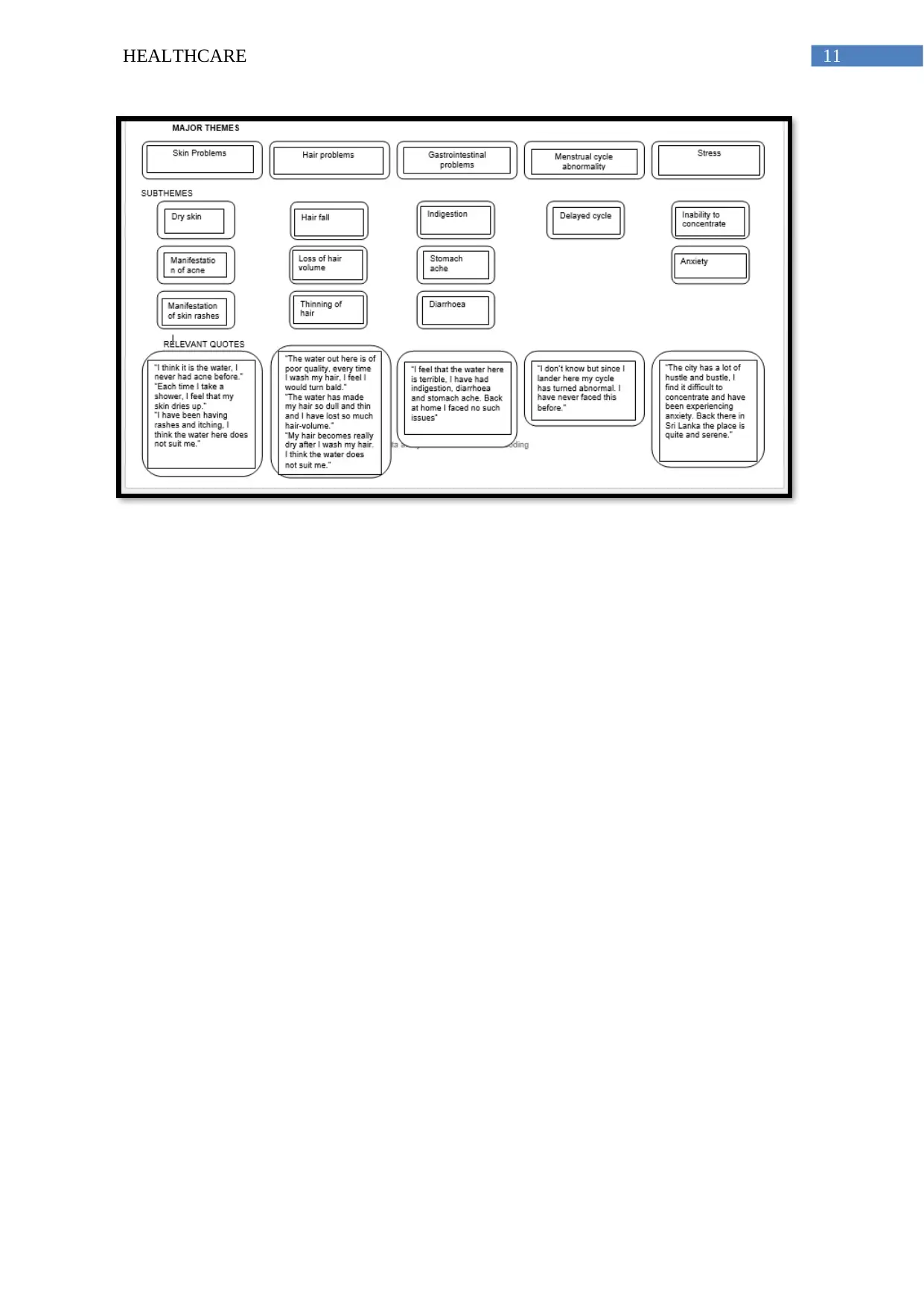
11HEALTHCARE
⊘ This is a preview!⊘
Do you want full access?
Subscribe today to unlock all pages.

Trusted by 1+ million students worldwide
1 out of 24
Related Documents
Your All-in-One AI-Powered Toolkit for Academic Success.
+13062052269
info@desklib.com
Available 24*7 on WhatsApp / Email
![[object Object]](/_next/static/media/star-bottom.7253800d.svg)
Unlock your academic potential
Copyright © 2020–2025 A2Z Services. All Rights Reserved. Developed and managed by ZUCOL.





